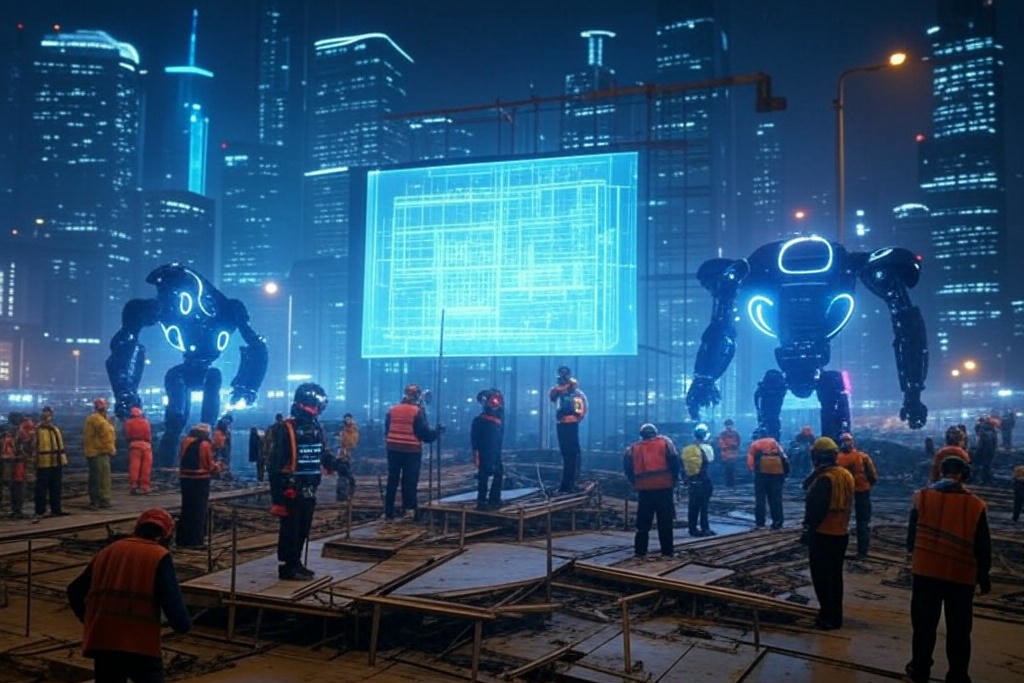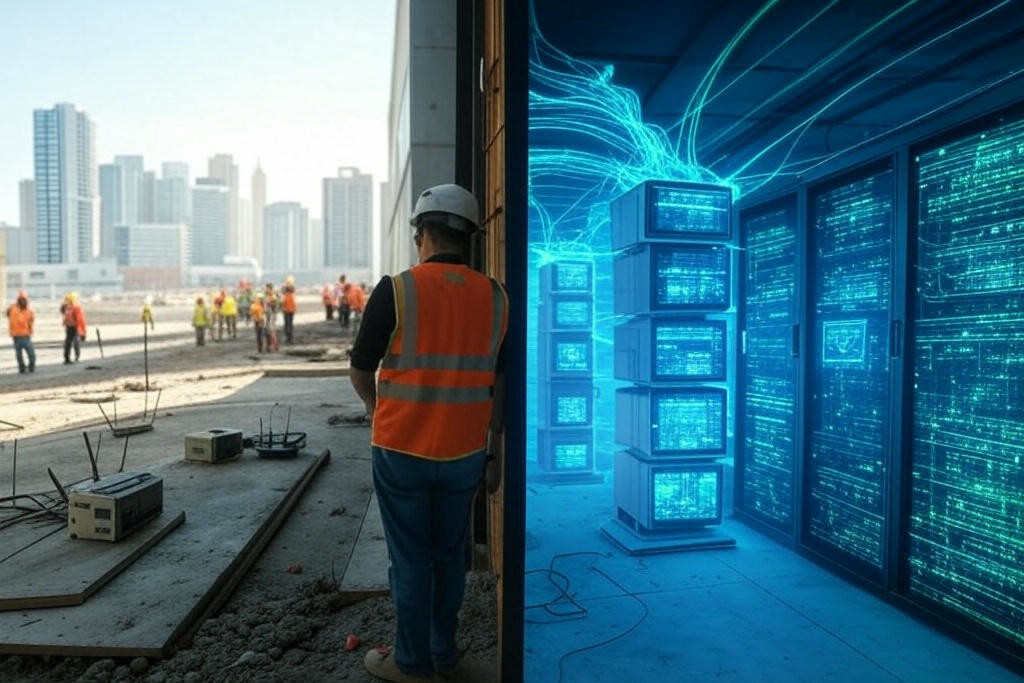Future BIM Trends
BIM as the linchpin of a smarter, more adaptive built environment, driven by ethical tech, climate resilience, and human-centric design.
1. AI-Driven Hyperautomation

Purpose: Automate complex decision-making and workflows.
Examples:
- Autonomous Clash Resolution: AI algorithms like Swapp auto-resolve clashes and suggest optimizations.
- Predictive Analytics: Tools like Buildots use AI to forecast delays and budget overruns.
Description: AI will evolve from generative design to real-time project management, analyzing historical data to preempt risks and automate repetitive tasks (e.g., scheduling, compliance checks). Machine learning models will refine energy efficiency and material selection, reducing human intervention by 40–60%.
2. Quantum-Powered Simulation

Purpose: Solve hyper-complex engineering challenges.
Examples:
- Material Optimization: Quantum algorithms testing millions of material combinations for carbon efficiency.
- City-Scale Traffic Modeling: D-Wave systems optimizing urban mobility networks.
Description: Quantum computing will enable BIM to simulate entire cities or analyze structural resilience at unprecedented speeds, tackling problems beyond classical computing limits. Early adopters like Autodesk Research are exploring quantum-enhanced finite element analysis (FEA).
3. Extended Reality (XR) Integration

Purpose: Merge physical and digital workflows seamlessly.
Examples:
- Mixed Reality (MR): Microsoft Mesh for collaborative holographic model reviews.
- VR Training Simulators: Hazardous scenario training for construction crews.
Description: XR will enable stakeholders to interact with BIM models in immersive environments, from on-site AR overlays (e.g., Trimble XR10) to virtual client walkthroughs. XR headsets will sync with IoT sensors for real-time data visualization.
4. Decentralized BIM Platforms (Blockchain 3.0)

Purpose: Secure, transparent, and decentralized collaboration.
Examples:
- NFT-Based Asset Tracking: Unique tokens for BIM components to ensure provenance.
- DAO Governance: Decentralized autonomous organizations managing public infrastructure projects.
Description: Blockchain 3.0 will move beyond smart contracts to create tamper-proof, decentralized BIM ecosystems. Platforms like BIMCHAIN will use NFTs to track material origins, while DAOs enable community-driven project approvals.
5. Self-Healing Digital Twins

Purpose: Enable proactive infrastructure maintenance.
Examples:
- AI-Powered Diagnostics: Siemens MindSphere predicting equipment failures.
- Autonomous Repairs: Drones patching cracks identified by digital twins.
Description: Digital twins will evolve into self-learning systems that autonomously adjust HVAC settings, schedule maintenance, and even dispatch repair bots. Integration with IoT and 5G will enable real-time synchronization with physical assets.
6. Human-Centric BIM Tools

Purpose: Prioritize user well-being and inclusivity.
Examples:
- Ergonomic Analytics: Tools like Space Syntax optimizing layouts for mental health.
- ADA Compliance Automation: AI auditing models for universal design compliance.
Description: Future BIM software will embed ergonomic and psychological metrics, ensuring designs enhance occupant well-being. AI will auto-generate inclusive spaces (e.g., autism-friendly environments) and validate accessibility standards.
7. Climate-Responsive BIM

Purpose: Design for resilience against climate change.
Examples:
- Dynamic Flood Modeling: ClimateStudio simulating sea-level rise impacts.
- Carbon Sequestration BIM: Tools tracking biogenic materials (e.g., hempcrete).
Description: BIM will integrate real-time climate data (e.g., IPCC reports) to test designs against future scenarios. Plugins like EC3 will expand to include circular economy metrics, while AI optimizes renewable energy integration.
8. Edge-to-Cloud BIM Ecosystems

Purpose: Enhance real-time collaboration and data processing.
Examples:
- 5G-Enabled Sites: Instant model updates via edge servers on remote sites.
- Federated Learning: Training AI models on localized data without central servers.
Description: Edge computing will reduce latency in BIM workflows, enabling real-time AR/VR and IoT integration. Cloud platforms like AWS BIM 360 will leverage edge nodes for faster rendering and data analysis.
9. Ethical AI Governance Frameworks

Purpose: Ensure responsible AI use in AEC.
Examples:
- Bias Auditing Tools: AI fairness checkers for equitable design outcomes.
- Transparency Standards: Open-source AI models for public scrutiny.
Description: As AI dominates BIM workflows, ethical frameworks will mandate transparency, bias mitigation, and accountability. Regulatory bodies like IEEE will standardize AI ethics, requiring impact assessments for automated decisions.
10. Space-BIM for Extraterrestrial Construction

Purpose: Design habitats for Moon, Mars, and beyond.
Examples:
- NASA’s Lunar BIM: Prototyping 3D-printed regolith structures.
- Autodesk’s SpaceTech: Simulating Martian habitat lifecycles.
Description: BIM will expand to off-planet construction, modeling microgravity impacts, radiation shielding, and resource utilization. Tools will integrate with robotics for autonomous extraterrestrial builds.
11. Bio-Hybrid BIM Systems

Purpose: Merge biology with construction technology.
Examples:
- Living Materials: Mycelium-based structures tracked in BIM.
- Photosynthetic Facades: Algae-integrated walls modeled for CO₂ capture.
Description: BIM will catalog bio-hybrid materials, simulating growth patterns and environmental impacts. Startups like BioMason use BIM to optimize bio-concrete curing processes.
12. Voice and Gesture-Driven BIM Interfaces

Purpose: Democratize BIM accessibility.
Examples:
- Voice Commands: Revit plugins controlled via Alexa/Cortana.
- Gesture Recognition: Leap Motion for hands-free model navigation.
Description: Natural user interfaces (NUIs) will replace traditional CAD inputs, enabling field workers to update models via voice or gestures, reducing training barriers and enhancing inclusivity.